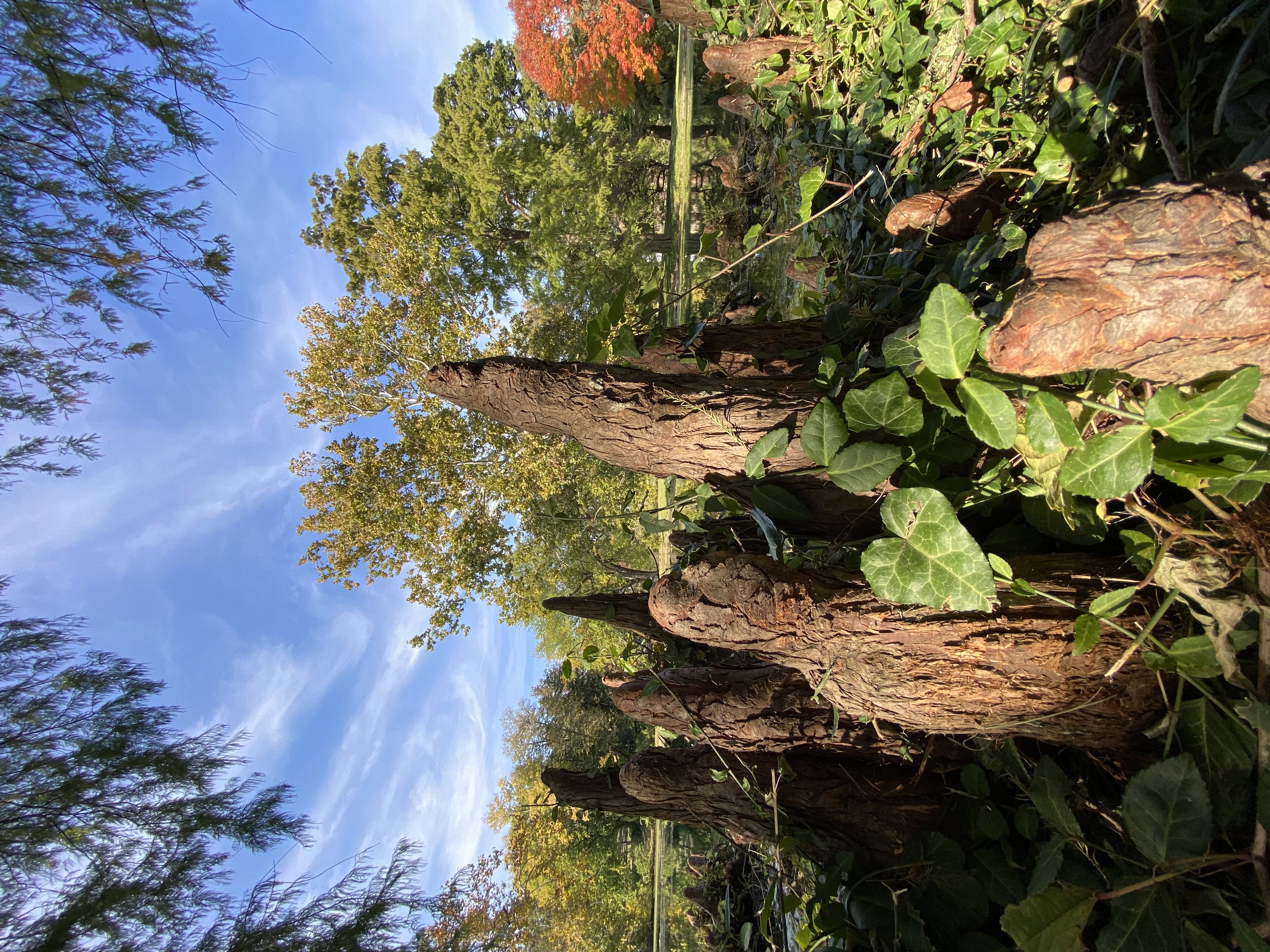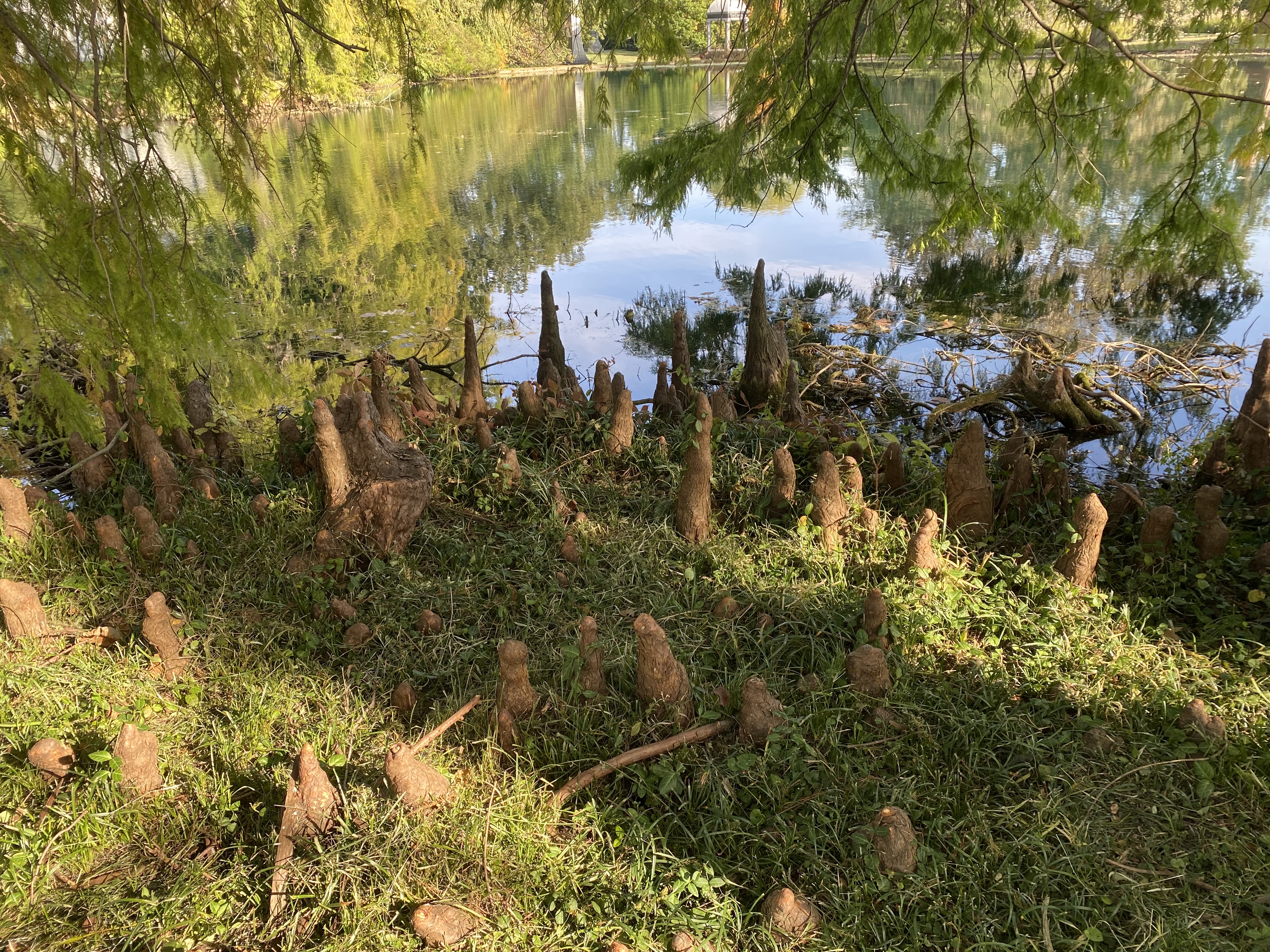
I had never seen or heard of cypress knees before last year, when I visited Spring Grove Cemetery in Cincinnati. It’s a beautiful place to walk around. The landscape is idyllic. Grass, grass, trees, trees, pond, swans, mausoleum, leaves, tombstone, tre—what the hell are those?

MICHAEL: We don’t know where it came from, how long it will last, or what caused it. Janet, what do we know?
JANET: We do know where it happened: here.
This is a quote from The Good Place. It could also be the sum total of scientific information on cypress knees.
I am exaggerating, but only a little. Nearly every article I’ve read on these marvelous knobby protuberances uses the word “mystery,” even the articles purporting to know what cypress knees are, what they do, and why they exist. We know that some species of cypress trees produce these knees, and that they’re made of bark-covered lumps of tree. We know they’re more common in low-lying areas near ponds and swamps. Some scientists posit that they help the tree with gas exchange. Others disagree. Most just shrug.
The most commonly cited work on the subject is “Cypress Knees: An Enduring Enigma,” published in the journal of the Harvard Arboretum in 2001. The second-most-cited work is from 1952, and there’s not a ton in between. One of the top results in my literature search was a chapter from a book called Real-Life X-Files: Investigating the Paranormal. I am not making this up.
This passage from an 1888 article might be my favorite find:
Nothing but shrewd guesses have been offered in explanation of the habit the Taxodizum has, of throwing up the excrescences known as ‘Cypress Knees.’ The generally accepted guess is that they serve to supply the submerged roots with air, but just how this tough woody tissue can act in this manner is not clear to the vegetable physiologist. This guess was in a measure supported by the statement that the tree produced knees only when in very swampy ground. I once believed this, but recently an instance came before me where on a dry bank, though near a lake, the knees were abundant.
I have seen them in dry places in Mississippi and Louisiana, but I fancied the situations were once wet, when the knees were first formed. A writer in an English horticultural journal hazards a wholly novel guess that they are abortive suckers, and in support of this states that a tap-root is always found beneath a knee. This last statement of fact is wholly new to me.
The knees were abundant! The situations were once wet!

I contacted the author of the 2001 article to see if he’d be willing to answer a few questions. To my delight, he agreed immediately, while admitting that he might not have much information to share. Then I sent him my questions. I never heard from him again.
That was enough of a sign for me. It was time to stop digging.
To someone like me who likes to learn everything about everything, The Case of the Mysterious Cypress Knees could feel unsatisfying, like a frustrating dead end. Instead, this apparent gap in our collective knowledge feels like a wink and a prize: a reminder that this world is positively rooted, knotted, and kneed with mysteries, sprouting right up from the ground.
*
Top image: still from the trailer for The Beast from 20,000 Fathoms via YouTube. The tree knees are mine.
Fascinating. I see many of these around the DC area in wetlands. Always been curious about them. Guess I always will be now.
I never noticed them while I was in the area! That’s wonderful.
This is one of my favorite mysteries. Drives me nuts that we don’t know more.
It’s truly perplexing/maddening/marvelous that something so common has completely eluded our understanding. Good job, trees. Keep your secrets.
https://www.sciencedirect.com/science/article/abs/pii/S036725302100027X
Bald Cypress knees, Taxodium distichum (Cupressaceae): An anatomical study, with functional implications
Flora Volume 278, May 2021, 15178
Yes! Thank you! I saw this study in my research and appreciated both the detailed breakdown of the phenomenon and the careful phrasing of the conclusion. Enthusiasm + expertise + humility is my idea of good science.
As a person who wants to know everything about everything, I’m still learning to appreciate a good mystery. If smarter people than me still don’t know after all this time, I’m going to chalk it up to magic!
I like that policy! And now I have Carly Rae Jepsen’s song “Happy Not Knowing” stuck in my head. Pretty sure it’s about a subpar man, but we can pretend it’s about weird tree parts.
I saw Cypress knees in a Florida slough last year. The naturalist there said they are thought to be extra support for trees growing in wet and unstable ground, giving the roots a better angle to withstand wind and fast-moving floods. I like to picture them as the knuckles of fingers digging into the ground.
Oh, I just love that image! Thanks so much for sharing.